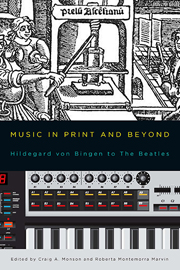Book contents
- Frontmatter
- Dedication
- Contents
- Acknowledgments
- Introduction
- 1 Robert Granjon and Music during the Golden Age of Typography
- 2 Publishing Music Theory in Early Cinquecento Venice and Bologna: Friends and Foes
- 3 Preaching to the Choir: Arts of Persuasion in the Converts of Italy
- 4 Music Distribution in London during Handel's Lifetime: Manuscript Copies versus Prints
- 5 Beethoven's Miniatures
- 6 “The Beautiful and the Ugly”: Travel Literature, Racial Theory, and a Schumann Song
- 7 Verdi's “Music of the Future”
- 8 The Suspended Voice of Amália Rodrigues
- 9 More than Mostly Mozart: Teddy Wilson's “China Boy”
- 10 Wanted Dead and Alive: Historical Performance Practice and Electro-Acoustic Music from IRCAM to Abbey Road
- 11 Lowinsky's Secrets
- 12 The Unknown Hildegard: Editing, Performance, and Reception (An Ordo Virtutum in Five Acts)
- List of Contributors
- Index
11 - Lowinsky's Secrets
Published online by Cambridge University Press: 05 March 2014
- Frontmatter
- Dedication
- Contents
- Acknowledgments
- Introduction
- 1 Robert Granjon and Music during the Golden Age of Typography
- 2 Publishing Music Theory in Early Cinquecento Venice and Bologna: Friends and Foes
- 3 Preaching to the Choir: Arts of Persuasion in the Converts of Italy
- 4 Music Distribution in London during Handel's Lifetime: Manuscript Copies versus Prints
- 5 Beethoven's Miniatures
- 6 “The Beautiful and the Ugly”: Travel Literature, Racial Theory, and a Schumann Song
- 7 Verdi's “Music of the Future”
- 8 The Suspended Voice of Amália Rodrigues
- 9 More than Mostly Mozart: Teddy Wilson's “China Boy”
- 10 Wanted Dead and Alive: Historical Performance Practice and Electro-Acoustic Music from IRCAM to Abbey Road
- 11 Lowinsky's Secrets
- 12 The Unknown Hildegard: Editing, Performance, and Reception (An Ordo Virtutum in Five Acts)
- List of Contributors
- Index
Summary
Edward Lowinsky's six-week sprint to finish his dissertation before leaving Germany in July 1933 is now musicological legend. Three years later he published the project in a similar rush when his advisor Heinrich Besseler warned him of an incoming edict forbidding the granting of doctoral degrees to Jews. In the thesis lies the germ for Lowinsky's controversial Secret Chromatic Art. His theory posited that in the second half of the sixteenth century, a small contingent of northern musicians with radical Protestant sympathies wrote pieces that appeared on the surface to set texts and use diatonic melodies condoned by the Church. Beneath that compliant surface, however, lurked secret chromatics and seditious meanings that remained hidden from the eyes and ears of the Inquisition. Describing moments of extreme dissonance, Lowinsky wrote the following words in his dissertation:
In those motets in which a scene is depicted, it is man in his deepest distress that is led before our eyes over and over again: Job; the prodigal son; Susannah, innocent and sentenced to death; Rachel lamenting her children, the abandoned Dido; a city afflicted by fate; and in innumerable examples, the desperate outcry of the psalmists. Standing as symbols for the inner state of an age in which a seemingly secure world has been thrown out of joint, the works of Clemens present the inner drama of the time in ways that those of Palestrina and Gombert do not.
- Type
- Chapter
- Information
- Music in Print and BeyondHildegard von Bingen to The Beatles, pp. 232 - 257Publisher: Boydell & BrewerPrint publication year: 2013

